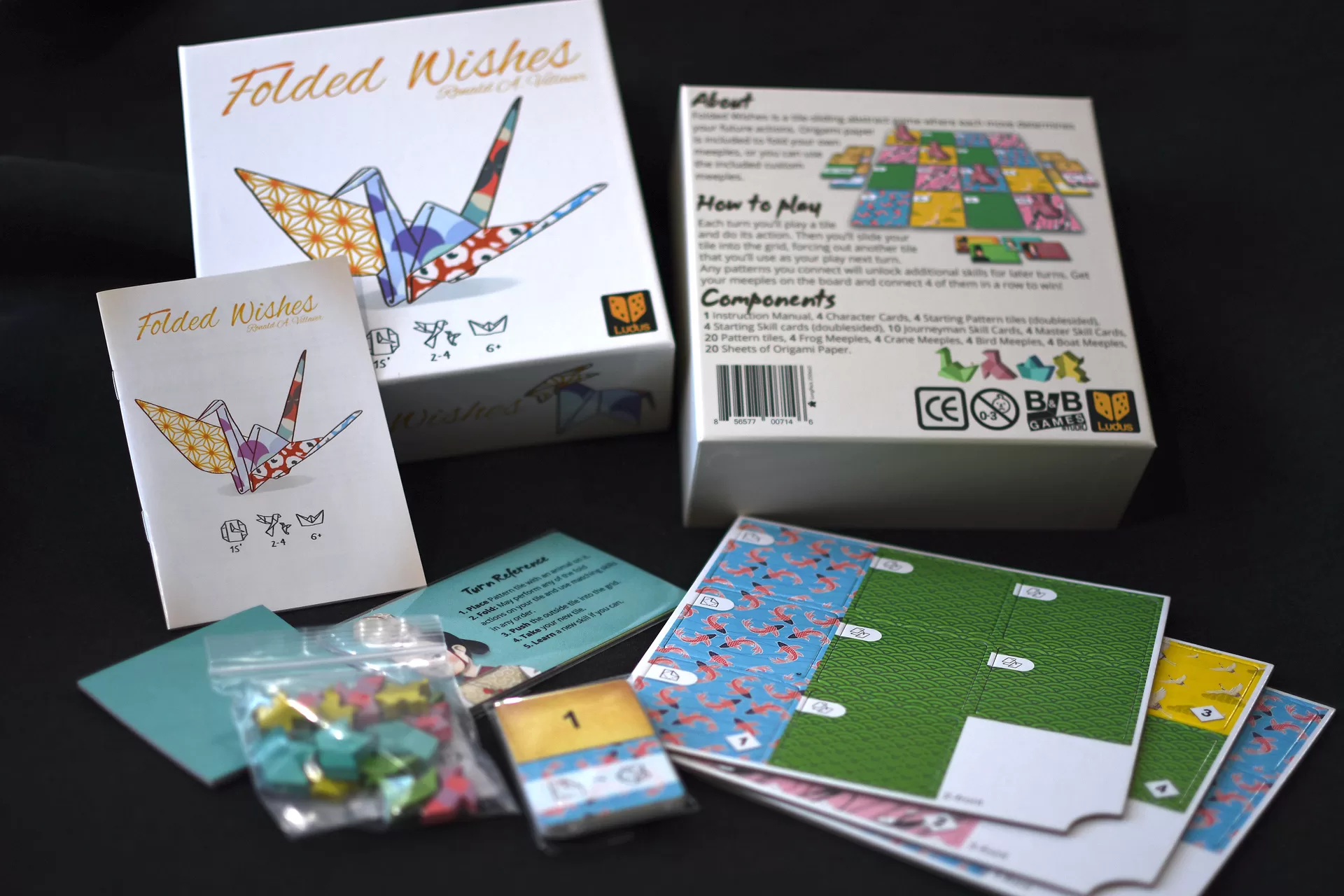Happy New Year! Here at Ungeek.ph, we pride ourselves in supporting local creators and designers. So to kickoff the New Year, we are interviewing designer Ron Villaver, as he talks about his game, Folded Wishes:

The game and it’s components
Ungeek: Hello Ron! Could you introduce yourself? What do you do for work?
Ron: I’m Ron Villaver, designer of Folded Wishes. I work in the IT industry. I’m also a tabletop advocate and community volunteer. I help run an online channel called VariablePlay talking about different topics about gaming. I also help run and organize weekly tabletop game nights in different locations in the metro area. Once a year we meet and run a community driven convention called BAECON – Boardgaming Adovcates and Enthusiasts Convention.
Ungeek: How did you get into game design? What other notable games have you designed?
Ron: I got into game design much like every avid gamer, dreaming about designing and publishing their own game some day. The first game I published back in 2015 was called Quotes & Verses, A game about sharing. Think of it like the game Card’s Against Humanity, but this one, for humanity. The other ones notable are Plataporma, a political satire pitching game and Watchlist ,a cooperative agent themed game about finding targets by asking yes or no questions simultaneously in real-time.
Ungeek: What was your inspiration for Folded Wishes?
Ron: It actually started with a question I asked myself, What mechanics can I come up with that feels like games like Onitama or Hive but allows more than 2 players? I researched other games that did just that. I found games like Codinca, Indigo and Labyrinth. From there I started experimenting with components and mechanics to achieve my desired experience.
Ungeek: Can you briefly describe how it plays?
Ron: In Folded Wishes, is an origami-themed game where players are racing to put all their origameeple tokens in a straight line. They do that by utilizing the tile fold actions to manipulate their tokens on the board nearer to the win while preventing others from doing the same. Along the way they may earn skills that enhance future tile actions they can perform.

A game session of Folded Wishes
Ungeek: Who do you envision it’s target market is?
Ron: The theme is calming, art design is colorful but the gameplay is more intense and cutthroat. The game is for players who are interested in solving spatial puzzles turn after turn. Progressing their objectives while monitoring the person after them and ensuring they don’t end their turn with a solvable puzzle that could possibly provide the next player to win.
Ungeek: What are some of the challenges in designing and publishing the game?
Ron: The challenge in the beginning was actually the theme. It didn’t start with the origami theme in the beginning. I tried various themes from hackers installing programs in the cloud, turtles braving the currents to star sheep delivering goods in the galaxy! Eventually though when we met the publisher, they came up with the perfect theme which we see today.
Ungeek: What has been the reception of Folded Wishes among people who have played it? What suggestions have they made, if any?
Ron: Reception is quite good, it is on its third print run as per the publisher. For the gamers that I got to meet, I get good feedback, mostly that they like how much the game makes them think, often saying its like a 5-dimension chess. The most memorable ones I met at Singapore, they really wanted a copy, but we were already sold out for the convention so they were willing to buy the worn-out demo copy just so they could go home that day with the game.
As for the suggestions, they were asking if I could make expansions or possible sequel to the game. To which I reply, we’ll see. ^_^
A Heavy Filler
Folded Wishes comes in a small, travel size box, perfect for tacking on to trips or even a short gaming session while out to dinner. It is easy to setup and play, and will take from 15 to 30 minutes per game and can play from 2 to 4 players. The online rulebook can be found here.

The pieces of the game
As mentioned, the game is easy to learn with simple rules. But as Ron also mentions, the game is a spatial puzzle, and it is a thinky puzzle at that. At it’s core, it is a game of tile laying and shifting, and pattern building. The game state always changes as players take their turns, so it can be difficult to plan your moves in advance. Nonetheless, careful action selection and grid placement; and anticipation of opponent moves will win a good player the game.
As simple and small as the game looks, this is in fact quite a heavy game which may take too much brain power for the recommended 6 year old to play and enjoy. In fact, I would not even call this a family game; this is a game for enthusiast boardgamers who are looking for a quick playing yet meaty game they can easily throw into their bag for a trip or get together. As such, there is a slight disconnect with gameplay and the way the game looks – one can easily mistake the packaging as a game suitable for children and non gamer families.
Charming components, quick playtime and brain burning grid movement. If you enjoy heady puzzles in a small package this game is for you.


